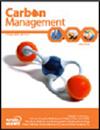探索印度尼西亚制造业二氧化碳减排潜力:对企业特征的分析
IF 3.2
4区 环境科学与生态学
Q3 ENVIRONMENTAL SCIENCES
引用次数: 2
摘要
摘要本研究探讨了印尼制造业如何通过企业特征有效地减少二氧化碳排放。确定具有最大减少二氧化碳排放潜力的企业特征是很重要的。采用对数平均分割指数(LMDI)方法,将2010-2018年期间二氧化碳排放分解为影响二氧化碳排放变化的关键因素,如经济活动、产业结构、能源强度、能源结构和排放系数。研究结果表明,各工业子部门的二氧化碳排放量变化各不相同。与拥有其他技术的公司相比,高科技公司的平均排放量最低。大型企业的排放量低于中小型企业。外国私营企业的排放量低于国内私营企业。平均而言,爪哇-巴厘岛地区的公司比爪哇-巴厘岛以外的公司排放量最高。出口企业的平均排放强度低于非出口企业。这项研究的新颖之处在于,它分析了影响企业集团二氧化碳排放变化的因素的影响,从而使政策制定者能够关注某些企业集团(即那些密集使用能源最多、效率低下、使用低质量能源的企业)二氧化碳排放的潜在减少。利用企业特征的比较分析表明,能源密集型企业的经济增长决定了印尼制造业二氧化碳排放的变化。本文章由计算机程序翻译,如有差异,请以英文原文为准。
Exploring the mitigation potential for carbon dioxide emissions in Indonesia’s manufacturing industry: an analysis of firm characteristics
Abstract This study investigates ways to effectively reduce carbon dioxide (CO2) emissions in Indonesia’s manufacturing industry, by firm characteristics. It is important to determine the firm characters that have the greatest potential to decrease CO2 emissions. The Logarithmic Mean Divisia Index (LMDI) method is used to decompose CO2 emissions into the key factors influencing changes in CO2 emissions, such as economic activity, industrial structure, energy intensity, energy structure, and emissions coefficient during the 2010–2018 period. The findings indicate that changes in CO2 emissions in industrial sub-sectors vary. High technology firms had the lowest average emissions compared to firms with other technology. Large-sized firms had the lowest emissions than small and medium firms. Foreign private firms had lower emissions than national private firms did. Firms in the Java–Bali location had, on average, highest emissions than those outside Java–Bali. Exporting firms had lower average emissions intensity compared to non-exporting firms. This study’s novelty is an analysis of the effect of components that affect changes in CO2 emissions in firm groups based on their characteristics so that policymakers can focus on the potential reduction in CO2 emissions in certain groups of firms, namely firms that use the most energy intensively, is inefficient, and uses low-quality energy. Comparative analysis using firm characteristics reveals that energy-intensive firms’ economic growth determines changes in CO2 emissions in Indonesia’s manufacturing industry.
求助全文
通过发布文献求助,成功后即可免费获取论文全文。
去求助
来源期刊

Carbon Management
ENVIRONMENTAL SCIENCES-
CiteScore
5.80
自引率
3.20%
发文量
35
期刊介绍:
Carbon Management is a scholarly peer-reviewed forum for insights from the diverse array of disciplines that enhance our understanding of carbon dioxide and other GHG interactions – from biology, ecology, chemistry and engineering to law, policy, economics and sociology.
The core aim of Carbon Management is it to examine the options and mechanisms for mitigating the causes and impacts of climate change, which includes mechanisms for reducing emissions and enhancing the removal of GHGs from the atmosphere, as well as metrics used to measure performance of options and mechanisms resulting from international treaties, domestic policies, local regulations, environmental markets, technologies, industrial efforts and consumer choices.
One key aim of the journal is to catalyse intellectual debate in an inclusive and scientific manner on the practical work of policy implementation related to the long-term effort of managing our global GHG emissions and impacts. Decisions made in the near future will have profound impacts on the global climate and biosphere. Carbon Management delivers research findings in an accessible format to inform decisions in the fields of research, education, management and environmental policy.
 求助内容:
求助内容: 应助结果提醒方式:
应助结果提醒方式:


